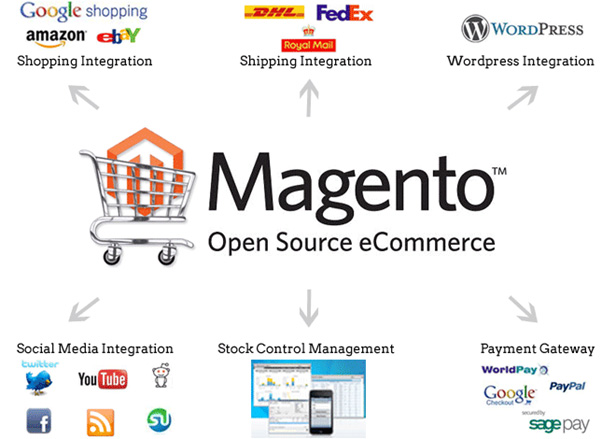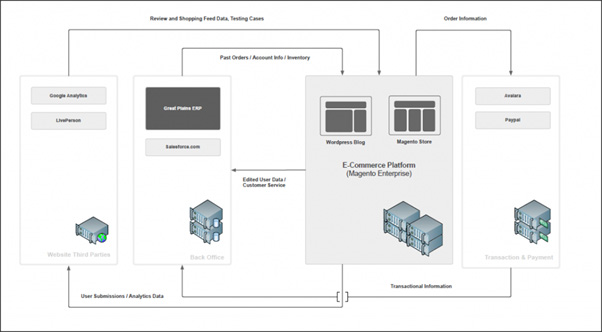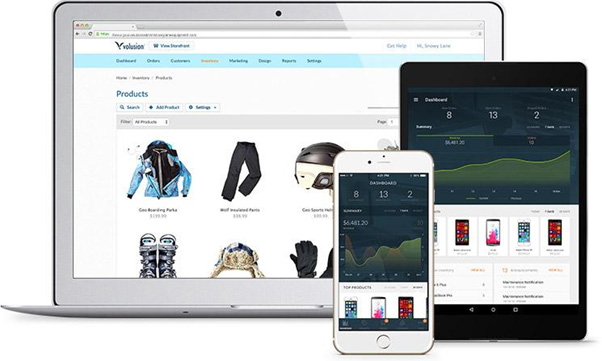If you’ve got the entrepreneurial itch, you might be considering selling products online.
If so, welcome to the world of third-party ecommerce platforms.
Using third-party ecommerce platforms is generally a good idea. In this article, I will walk through some of the issues that will help you power your dream and boost your revenue.
Are Third-Party Ecommerce Platforms Truly Effective At Boosting Revenue?
The simple answer is yes.
Think of it this way. When you start a business — any business — there are a million things to do. Creating a website, selecting products, shipping products, managing payment options, and improving sales can all be overwhelming.
Ecommerce platforms simplify everything.
They do a lot of the work for you. The fact that ecommerce platforms employ smart marketers with years of experience, savvy developers, and talented designers means that you get to purchase all of this for a fraction of the price.
Here are some of the ways that third-party platforms can boost revenue:
- High volume order processing
- Multiple payment options — PayPal, BitCoin, different currencies and languages
- Mobile checkout interface
- Built-in email marketing and newsletters
- Gift card and coupon integration
- Abandoned cart protection
- Ecommerce experts and consultants available for advice (and upsells)
Managing all of these features on your own is incredibly time-consuming and can be counterproductive.
At the very least, starting out with a third-party ecommerce platform makes solid business sense.
The point is, third-party ecommerce providers will boost your revenue. As long as you’re using good business sense, tracking your analytics, following the money, and working smart, you gain an incredible advantage through choosing a reliable and feature-rich ecommerce platform.
What Are The Disadvantages Of Using A Third-Party Ecommerce Platform?
With all the massive advantages behind third-party ecommerce systems, are there any disadvantages?
Yes, but…
First, the but. This article focuses on the revenue side of ecommerce. There are, of course, other factors to keep in mind — important ones. You want to build a brand, create a legacy, establish a business, be known for something great, get bought out, achieve high valuation status, pivot your business in another direction, etc.
All of that is important, valid, and worthy of deep consideration.
At the same time, a business exists to make money. Revenue must be part of your consideration if you expect to stay afloat, let alone thrive.
(Video) How To Increase Your eCommerce Revenue With Amazon – Module 3 – Part 1 – eCommerce Unlocked
Often, the most effective way to do that is by choosing a third-party platform. These systems are designed to save time and money, a business’s two most essential assets.
By choosing an alternate route —no third party platforms involved —you are embracing a new set of risks and disadvantages.
In this case, the risks and disadvantages are lost revenue potential. Why? Because you are spending more time and money creating your own platform rather than using an existing one.
Now, let me share some of those risks.
You Are Building Your Business On A Platform Owned By Someone Else
This is inherently risky. Anytime you surrender something as foundational as a platform, you’re surrendering a great deal of control.
- What if the third-party platform goes under? You’re toast.
- What if the third-party platform drastically changes their policy? Your business could suffer.
- What if the third-party platform jacks up their prices? You pay the difference.
By purchasing someone else’s platform, you lose control.
You Are Limited In What You Can Do
If you are selling on a third-party platform, you have to work within their structure and with their features.
It’s harder to perform custom split testing or iterate CRO changes on the fly. With most ecommerce platforms, you are using their proprietary CMS.
For those who aren’t developers or designers, this is fine. You’re not necessarily interested in tweaking CSS files or integrating an API.
But for those who want to take their business to new levels of disruption and innovation, this limitation may turn into a serious frustration.
The issue isn’t as stark as it might seem. In other words, you don’t have to choose between surrendering all control to a third-party and creating your exclusively owned site and system.
There are choices between full-service platform providers and solution providers, for example.

As an illustration, you can choose an open source ecommerce system like Magento to provide ecommerce functionality while at the same time controlling a vast swath of design and development.

You control most aspects of the operation, while Magento provides your ecommerce power.
(Video) Leveraging 3rd Party eCommerce Data

Source
Or, you can create a WordPress site, integrate powerful ecommerce plugins like WooCommerce, and have your store up and running on a site that you design and control.
You may create your own ecommerce site, then choose to use third-party providers for select aspects like your payment gateway.
What Are The Third-Party Ecommerce Platform Options?
You have choices.
There are dozens of ecommerce platforms to choose from. To simplify, here are the top six.
1. Shopify
Shopify is the most well-known online shopping tool. It’s relatively easy to set up a store and start selling products. A lot of smaller shops choose Shopify because it’s inexpensive.

There are some nice perks to using Shopify. Some have a price; others are free. For example, you can sell unlimited products and have unlimited bandwidth. Perks that will cost you are features like abandoned shopping cart recovery.
Starting price: $14/month
2. BigCommerce
BigCommerce is another option, complete with some of the advanced ecommerce features that you’d want for high conversion rates.

More mid-sized ecommerce sites choose BigCommerce. Their marketing and conversion tools provide some helpful features to improve sales.
Starting price: $29.95/month
3. Aabaco Small Business (formerly Yahoo)
Yahoo entered the ecommerce game early, and they are still one of the largest players. However, they didn’t grow as fast as newer startups, and their market share started to slip. They recently changed their name to Aabaco.
![]()
(Video) Increase Your Store Revenue With Mailchimp + @WooCommerce
Aabaco allows for UPS shipping integration, quick payment setup, and helpful actionable insights for store owners.
Starting price: $19.95/mo
4. Squarespace
Squarespace has some great marketing, and their templates are slick and functional. Even if you have no eye for design, you can launch an impressive interface very quickly.

With Squarespace, you are limited to using Stripe for payments and transactions. Stripe’s payment processing is safe and reliable, but it charges a 2.9% fee, plus 30 cents per transaction.
Starting cost: $10/mo
5. Amazon
Amazon is the world’s largest ecommerce platform. With more than 2 million sellers and 200 million customers, it has a lot of action.
Unlike the other platforms, Amazon is focused on selling products, not building your own ecommerce store. While this may not be recommended for some business models, it’s actually a huge advantage. Amazon has an existing customer base and brand integrity.
Amazon is also competitive. In order for your product to sell well, you’ll need to rank higher for customer queries. This requires getting solid reviews and seller ratings. An entire cottage industry of consultants and marketers has arisen to fill the need for Amazon marketing assistance.
Cost: $39.99 for more than 40 items a month. $0.99 plus fees for fewer than 40 items a month. The most successful sellers choose to sell Fulfilled By Amazon (FBA), which allows their products to be packed and shipped by Amazon. This opens up the product to Amazon Prime eligibility. The fee structure is different for FBA.
6. Volusion
Many larger sites choose Volusion. Their powerful features and solid reputation in the marketplace make them a great choice.

Volusion merchants have generated more than $18 billion in sales, which says a lot about the power of the platform. You can also choose from more than 50 gateways, which gives you a lot of freedom.
Starting price: $15/mo
What If I Want To Build My Own Brand?
You can easily build your own brand using any third-party platform. These sites are designed to help business owners launch quickly and successfully.
The only possible exception is Amazon. Even with Amazon, you can build a successful independent brand, and simply use their platform as an outsourced fulfillment source.
(Video) CRM Software and Cloud Sales Platform Tips: How to Boost Profits and Market Share ♻️ TOOLS S1•E3
When you sell on Amazon, you lose some of the proprietary store power that other ecommerce platforms have. What you lose in independence, however, you may gain in sales and revenue.
For many ecommerce businesses, priority one is to make money. There are ways to make a lot of money on Amazon, by understanding the ranking algorithm, generating reviews, and marketing successfully.
Your brand can be established independent of Amazon, but it won’t be as visible to Amazon buyers.
Take this product, for example. It’s a digital stylus.

The brand, FiftyThree, gets very low visibility above the fold. All you see is their brand name in the product, and a small “by FiftyThree.”
When you scroll below the fold, however, you get a bigger picture of the brand. They provide a video, headshots of the startup team members, a Q&A surrounding their brand, and more information about the product.
Not all brands get this level of visibility and exposure, but the point is this:You won’t lose your brand identity by selling on Amazon.

FiftyThree has a robust brand presence and successful website apart from their Amazon sales.

Boosting revenue means that you’ll choose the platforms and options that provide the most promise, flexibility, power, and customers.
Keep in mind, it’s not an either/or proposition. You can build your own brand and use a third-party platform for all its worth. The whole idea is that the third-party platform enhances your ability to generate revenue and establish your brand.
Conclusion
If you are new to ecommerce, selling physical products, not a developer, and not launching an advanced SaaS or PaaS, then you will boost your revenue by using a third-party platform.
If on the other hand, you’re a kick-ass developer with a world-changing dream, the trajectory of a Unicorn, and visions of disruption, then you’ll probably not be choosing, say, Shopify or BigCommerce.
And that’s okay.
(Video) My 4 Main Ways Of Driving Sales Traffic To My Online Store: For Beginners!
For maximum revenue boosting power, a third-party platform could be your best choice.
What reasons do you have for choosing a third-party ecommerce platform?
Selling through these platforms will open up your business to new customers browsing the marketplace who might be completely unfamiliar with your brand. Using third-party ecommerce platforms increases the exposure your business receives and can result in new sales.
How can third-party increase sales? ›
Use more specific keywords that are targeted to the products you sell. Use a combination of generic, category-based and product-related keywords to make your product discoverable. Avoid choosing too broad or competitive keywords as it will increase the bounce rate and lead to a low conversion rate.
How can I improve my ecommerce platform? › 10 tips to improve e-commerce website design
- Optimise your product imagery.
- Enable your customers to easily find what they need.
- Ensure your product information is accurate.
- Include customer quotes.
- Build dynamic page designs that use a mixture of content blocks.
- Create a clear conversion path.
What is a third party E-commerce platform? ›
What is a Third Party Website for ECommerce? Put simply, third party websites easily host and manage online sales for businesses for a fee. For more context, third party websites display your product on their platform, deal and collect orders, manage payments, ship orders, and track delivery.
What is a third party platform? ›
To set up your online business, you can also set up an online shop using third-party platforms, which is any software developed externally to you or your main website provider. Another alternative would be to list your products on well-known marketplaces.
How do third party sellers work? ›
A 3rd party seller (3P) uses Amazon as a marketplace to sell directly to shoppers. Third-party sellers handle customer service for orders shipped directly from them unless the order is eligible for Amazon Prime.
How do third party retailers work? ›
Adding a third party brand allows retailers to trial the introduction of new types of products and new focuses for products without having to go through the product development. They also provide the chance for retailers to extend their offering in front of another brand’s audience.
How can eCommerce increase growth? › Tactics To Improve Ecommerce Sales
- Grow Your Brand and Trust. …
- Build and Effectively Manage Your Email Marketing Strategy. …
- Drive More Traffic With Facebook Advertising. …
- Test and Test to Avoid complacency. …
- Know Your Numbers, and Stick to Them. …
- Understand Your Customer on a Deep Level. …
- Invest in Customer Service Technology.
How do you grow in eCommerce? › 9 ways to grow your eCommerce business in 2022
- Ramp up your customer service.
- Publish blogs and newsletters.
- Post on social media.
- Give Google Shopping a go.
- Use omnichannel marketing.
- Grow your email list.
- Sell internationally.
- Personalise your customers’ experience.
What are the benefits of e-commerce? › Understanding the advantages of ecommerce
- Faster buying process.
- Store and product listing creation.
- Cost reduction.
- Affordable advertising and marketing.
- Flexibility for customers.
- No reach limitations.
- Product and price comparison.
- Faster response to buyer/market demands.
How can e business improve performance? ›
5 Proven Ways To Improve E-Commerce Business Performance
- Add Live Chatting Systems. Firstly, you should integrate live chatting systems, or chatbots, to your eCommerce platform. …
- Use Email Marketing. …
- Utilise Inventory Management Software. …
- Experiment with Paid Traffic. …
- Tighten Up Your Shopper User Experience.
How do you increase customer base in eCommerce? › 10 Secrets to increase customer base for your E-commerce store
- Target Your Existing Customers.
- Acquire Trust.
- Prioritize Excellent Customer Service.
- Maintain an Open Discussion with Opinions and Feedbacks.
- Out of the Box Offers for the Customers.
- Personalize in Real-Time.
- Incorporate Product Videos.
- Social Media Engagement.
What are examples of third party websites? › Third-party code is everywhere….
Providers.
| Rank | Third party domain | Percent of requests |
|---|---|---|
| 1 | fonts.gstatic.com | 2.53% |
| 2 | www.facebook.com | 2.38% |
| 3 | www.google-analytics.com | 1.71% |
| 4 | www.google.com | 1.17% |
6 more rows What are the advantages to selling your products online via third party retailers? ›
- Increased company revenue. Selling your products through a third party can greatly enhance your company’s revenue by bringing in new clients to your company. …
- Cost Effective. …
- Less Risk. …
- Exposure. …
- Revenue. …
- Popularity. …
- Logistics. …
- Marketing.
How does an ecommerce platform work? ›
An e-commerce platform is the software application where both parties, the seller and the consumer, come and play their role. Essentially, a consumer should be able to use an e-commerce platform to discover products, shop around using a cart, and then check out.
Why 3rd party integration is important? ›
Third party integrations allow you to quickly add features and tools to your business processes that might take many months to develop on your own. Even if you have the resources to develop tools in-house, those tools might need a great deal of time to refine.
Who is considered third party? ›
A third-party is any company or individual with which or whom you have entered into a business relationship to: Provide goods and services for your own use. Perform outsourced functions on your behalf. Provide access to markets, products and other types of services.
Is Shopify a 3rd party platform? ›
Shopify is a third party store. It is not affiliated with any one company or brand, and it offers a wide variety of products from different brands. This makes it a great option for those who want to shop around and compare prices.
How do you motivate customers to buy your product? › Fifteen experts from Forbes Coaches Council offer their best techniques for gently encouraging clients to pick you.
- Listen And Clarify Their Desires. …
- Demonstrate Your Expertise. …
- Don’t Sell Services, Sell Solutions. …
- Fix Your Value Proposition First. …
- Focus On The Customer. …
- Reward Them For Action. …
- Build Trust In Your Answers.
What are the strategies to attract customers? › 5 Tips for Attracting New Customers
- Identify Your Ideal New Customers. …
- Use Direct Response Marketing to Attract Customers. …
- Give Something Away to Entice New Customers. …
- Give Your Business a Face Lift to Increase Sales. …
- Get The (Right) Word Out.
What is the role of third party IT services? ›
What are third-party services? Third-party services are web-based technologies that are not exclusively operated or controlled by a government entity or that involve significant participation of a nongovernment entity. The FTC uses third-party services to assist it in communicating or interacting with the public.
What is an example of a third party vendor? ›
Examples of third-party vendors
Consultants and advisors. Marketing companies. Short and long-term contractors. Telephone companies.
What is an example of a third party service provider? ›
Common third-party service providers include web-hosting platforms, marketing agencies, software services (including analytics software), contractors, and consultants.
What does it mean to make Internet sales through a third party? ›
Third-party e-commerce businesses market and sell products directly to consumers through a channel like Amazon or eBay. Sellers pay a fee for the privilege – typically on a per sale basis.
What are third party products? ›
“Third party product” refers to any product and/or service of third party which is offered by or through the intermediary of the Bank.
What does 3rd party seller mean? ›
In E-commerce, “3rd Party (3P) source” refers to a seller who publishes products on a marketplace, without this marketplace to own or physically carry those products. When an order comes in, a 3P seller has the item on hand and fulfills it.
How can a business increase sales? ›
- INTRODUCE NEW PRODUCTS OR SERVICE. Provide a broader range of products or services for your clients. …
- EXPAND TO NEW DOMESTIC MARKETS. …
- ENHANCE YOUR SALES CHANNELS. …
- MARKETING ACTIVITIES. …
- CHANGE YOUR PRICE. …
- BE AWARE OF THE COMPETITION. …
- IMPROVE COMMUNITY RELATIONS. …
- DON’T NEGLECT CUSTOMER SERVICE.
How do I grow my eCommerce business 2022? › Grow Your eCommerce Business in 2022: 10 Ways to Increase…
- Build a community. …
- Think like a brand marketer. …
- Explore new sales channels. …
- Offer eCommerce Gift cards. …
- Live stream shoppable events. …
- Nudge zero-party data collection. …
- Construct a customer advisory program.
How can I grow my online business in 2022? › How to Grow and Scale Your Ecommerce Brand in 2022
- Create an SEO strategy. SEO will stay golden in the coming year. …
- Leverage social commerce. …
- Provide rich shopping experiences. …
- Collect social proof. …
- Get known for excellent customer service. …
- Omnichannel presence.
How can I grow my business? › Although growing your small business will take time and energy, there are 10 strategies you can use to help accelerate business growth.
- Do Your Research. …
- Build a Sales Funnel. …
- Increase Customer Retention. …
- Participate in Networking Events. …
- Practice Corporate Social Responsibility. …
- Form Strategic Partnerships.
What is business strategy in e commerce *? ›
An e-business strategy defines a long-term plan for putting in place the right digital technology for a company to manage it’s electronic communications with all partners – that’s internal through the intranet and externally through to customers, suppliers and other partners.
What is e-business growth strategy? ›
An e-business growth strategy might include taking advantage of new marketing opportunities to target a larger audience for their product, or creating an affiliate marketing program for your product or service.
How can I make sales faster? ›
- Be Present With Clients And Prospects. …
- Look At Product-To-Market Fit. …
- Have A Unique Value Proposition. …
- Have Consistent Marketing Strategies. …
- Increase Cart Value And Purchase Frequency. …
- Focus On Existing Customers. …
- Focus On Why Customers Buy. …
- Upsell An Additional Service.
What are the marketing strategies in online selling? › 11 best digital marketing strategies
- SMS marketing.
- SEO.
- Email marketing.
- Influencer marketing.
- Affiliate marketing.
- Google Ads.
- Podcasts.
- Social media marketing.
How do you increase sales? › Secrets of increasing and closing sales:
- Ask questions and listen.
- Showcase your full potential.
- Assume the sale.
- Stand out.
- Tell your story visually.
- Overcoming objections in sales.
- Don’t fear giving away too much upfront.
- Understand what motivates your customers to buy.
What is E commerce 5C model? ›
The 5 C’s are “company,” “collaborators,” “customers,” “competitors,” and “context.” The initial step is to understand what each represents and how it might help your business’s marketing. The 5C marketing framework can help a business understand its position in the marketplace.
What are the 4 general ways to increase sales? › Believe it or not, there are only four ways to increase your revenue:
- Increase the number of customers.
- Increase the average transaction size.
- Increase the frequency of transactions per customer.
- Raise your prices.
What are the 4 selling strategies? ›
The four basic sales strategies salespeople use are script-based selling, needs-satisfaction selling, consultative selling, and strategic-partner selling. Different strategies can be used with in different types of relationships.
Which online selling strategy is the most effective to customers? › Fortunately, there are a number of ways that can help you boost your bottom-line through online sales.
- Invest in quality product images. …
- Show off customer testimonials and trust signals. …
- Invest in mobile optimization. …
- Offer a money-back guarantee. …
- Provide as many payment options as possible. …
- Use social media.
How social media can increase online sales? › How to Increase Sales With Social Media
- Use Interactive Posts to Entice and Educate. …
- Share User-Generated Content. …
- Use the Social Media Networks Your Audience Uses. …
- Use Shoppable Posts. …
- Enlist the Help of Influencers and Customers. …
- Promote Flash Sales. …
- Create Brand Specific Hashtags. …
- Stay Consistent with Your Posting Schedule.
How can I promote my online business on social media? ›
6 Creative Ways to Promote Your Product on Social Media
- Run Contests on Social Media to Attract Attention. …
- Advertise your product to reach wider. …
- Run deals and promo codes on social media. …
- Provide Social Proofs to build trust in your product. …
- Share Creative Visual Content for Better Engagement.
How can a business increase income? › 10 Ways to Increase your Business Revenue
- Expand your Market Reach. Trust us. …
- Review Your Pricing Strategy. …
- Discounts/ Offers. …
- Communication. …
- Redesign your Sales Collaterals. …
- Develop Relations. …
- Motivate your Sales Team & External Sales Partners. …
- Open every possible Payment Options.
How can I increase my sales without spending money? › Small Business Tip: Increase sales without spending a lot of…
- Identify top customers and offer them more. …
- Customize your sales pitch for each client. …
- Increase goals for referrals and sales will increase. …
- Interact personally with customers more frequently.
How do you sell a product effectively? › How to market a product effectively
- Position your product. To market your product effectively, you must correctly position your product in the market. …
- Identify your audience. …
- Research your competition. …
- Find the right price. …
- Create a product marketing strategy. …
- Launch your product. …
- Refine.
What are the five C’s of marketing? ›
The 5 C’s of Marketing Defined. The 5 C’s stand for Company, Collaborators, Customers, Competitors, and Climate. These five categories help perform situational analysis in almost any situation, while also remaining straightforward, simple, and to the point.
What is B2B and B2C type of e-commerce? ›
B2B stands for ‘business to business’ while B2C is ‘business to consumer’. B2B ecommerce utilises online platforms to sell products or services to other businesses. B2C ecommerce targets personal consumers.
Is an example of C2C e-commerce transaction? ›
The most prominent examples of C2C include eBay, an online auction site, and Amazon, which acts as both a B2C and a C2C marketplace.
Videos
1. Comparing EVERY Print on Demand Platform that Works with Printful 2. Learn International SEO For Ecommerce 3. How to Attract Customers – 5 Marketing Strategies to Dominate Social media 4. Inside the Innovation: Optimizing Revenue-Boosting Authorization Rates and Reducing Network Declines 5. Create New Revenue Streams FAST with eCommerce 6. Revenue Generation Models for Your Business
Author: Allyn Kozey
Last Updated: 11/18/2022
Views: 5464
Rating: 4.2 / 5 (63 voted)
Reviews: 94% of readers found this page helpful
Name: Allyn Kozey
Birthday: 1993-12-21
Address: Suite 454 40343 Larson Union, Port Melia, TX 16164
Phone: +2456904400762
Job: Investor Administrator
Hobby: Sketching, Puzzles, Pet, Mountaineering, Skydiving, Dowsing, Sports
Introduction: My name is Allyn Kozey, I am a outstanding, colorful, adventurous, encouraging, zealous, tender, helpful person who loves writing and wants to share my knowledge and understanding with you.
© 2023 Soviti. All Rights Reserved.